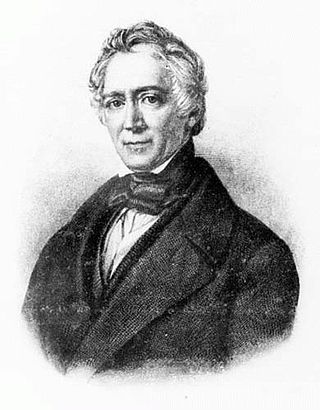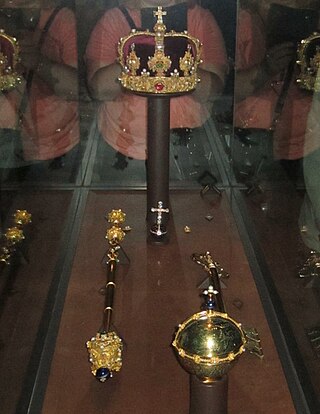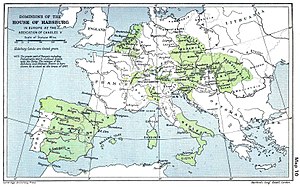
Kołobrzeg is a port city in the West Pomeranian Voivodeship in north-western Poland with about 47,000 inhabitants. Kołobrzeg is located on the Parsęta River on the south coast of the Baltic Sea. It is the capital of Kołobrzeg County.

Syldavia is a fictional country in The Adventures of Tintin, the comics series by Belgian cartoonist Hergé. It is located in the Balkans and has a rivalry with the fictional neighbouring country of Borduria. Syldavia is depicted in King Ottokar's Sceptre (1938–1939), Destination Moon (1950), Explorers on the Moon, The Calculus Affair (1954–1956), and Tintin and the Lake of Sharks (1972), and is mentioned in Tintin and the Picaros (1975–1976).

Crown jewels are the objects of metalwork and jewellery in the regalia of a current or former monarchy. They are often used for the coronation of a monarch and a few other ceremonial occasions. A monarch may often be shown wearing them in portraits, as they symbolize the power and continuity of the monarchy. Additions to them may be made, but, since medieval times, the existing items have been typically passed down unchanged, symbolizing the continuity of a monarchy.
A number of symbols of Europe have emerged since antiquity, notably the mythological figure of Europa.

Friedrich Ludwig Georg von Raumer was a German historian. He was the first scientific historian to popularise history in German. He travelled extensively and served in German legislative bodies.

The Holy Crown of Hungary, also known as the Crown of Saint Stephen, named in honour of Saint Stephen I of Hungary, was the coronation crown used by the Kingdom of Hungary for most of its existence; kings were crowned with it since the twelfth century. The Crown symbolized the King's authority over the Lands of the Hungarian Crown, and it was a key mark of legitimacy. Through the history of Hungary, more than fifty kings were crowned with it, with the last being Charles IV in 1916. The only kings not so crowned were Wladyslaw I, John Sigismund Zápolya, and Joseph II.

The Austrian Crown Jewels are the regalia and vestments worn by the Holy Roman Emperor, and later by the Emperor of Austria, during the coronation ceremony and other state functions. The term refers to the following objects: the crowns, sceptres, orbs, swords, rings, crosses, holy relics and royal robes, as well as several other objects connected with the ceremony. The collection dates from the 10th to the 19th centuries, and it reflects more than a thousand years of European history. It is kept in the Imperial Treasury at the Hofburg Palace in Vienna, Austria.

The Imperial crown of Russia, also known as the great imperial crown, was used for the coronation of the monarchs of Russia from 1762 until the Russian monarchy's abolition in 1917. The great imperial crown was first used in the coronation by Catherine the Great, and it was last worn at the coronation of Nicholas II. It was displayed prominently next to Nicholas II on a cushion at the State Opening of the Russian Duma inside the Winter Palace in St. Petersburg in 1906. It survived the 1917 revolution and ensuing civil war and is currently on display in Moscow at the Kremlin Armoury's State Diamond Fund.

The Imperial Regalia, also called Imperial Insignia, are regalia of the Holy Roman Emperor. The most important parts are the Crown, the Imperial orb, the Imperial sceptre, the Holy Lance and the Imperial Sword. Today they are kept at the Imperial Treasury in the Hofburg palace in Vienna, Austria.

The Imperial Crown of Austria is a crown formerly in use by the monarchs of the Habsburg monarchy. The crown was originally made in 1602 in Prague by Jan Vermeyen as the personal crown of Holy Roman Emperor Rudolf II, and therefore is also known as the Crown of Emperor Rudolf II. The crown was used as a private crown of the Holy Roman Emperors and Kings of Hungary and Bohemia from the House of Habsburg. In 1804 it became the official crown of the newly constituted Austrian Empire. After 1867 it remained the imperial crown of the Cisleithanian part of the Austro-Hungarian Empire until 1918.

Sweden's regalia are kept deep in the vaults of the Royal Treasury, underneath the Royal Palace in Stockholm, in a museum that is open to the public. The crowns and coronets have not been worn by Swedish royalty since 1907, but they are still displayed at weddings, christenings and funerals.

The Holy Roman Emperor received the imperial regalia from the hands of the Pope, symbolizing both the pope's right to crown Christian sovereigns and also the emperor's role as protector of the Catholic Church. The Holy Roman empresses were crowned as well.

A hoop crown, arched crown, or closed crown, is a crown consisting of a "band around the temples and one or two bands over the head". First used by the Carolingian dynasty, hoop crowns became increasingly popular among royal dynasties in the Late Middle Ages, and the dominant type of crown in the Modern Era.
Historical behaviour studies is a field of research in cultural history and cultural anthropology and a particular methodological approach to the study of human behaviour.

The Royal Porcelain Factory in Berlin, also known as the Royal Porcelain Manufactory Berlin and whose products are generally called Berlin porcelain, was founded in 1763 by King Frederick II of Prussia. Its actual origins, however, lie in three private enterprises which, under crown patronage, were trying to establish the production of "white gold" in Berlin from the mid-18th century onwards.

A Grade I-listed statue of Queen Anne stands on a pedestal alongside the north wall of No. 15 Queen Anne's Gate in Westminster, London. It portrays the queen wearing a brocaded skirt and bodice and an open cloak with the insignia of the Order of the Garter; on her head is a small crown and in her hands she holds an orb and sceptre. The statue, carved from Portland stone, stands on a plinth of the same material with the inscription ANNA REGINA. The pedestal consists of a fat "engaged" cylinder with a flat volute on either side, each with scrolls adorned with carved flowers and leaves. Neither the sculptor's identity nor the exact date of the work are known, but it is probably of the early eighteenth century.

The Luther Monument is a group of statues that was erected in Worms, Rhineland-Palatinate, Germany, to commemorate the Protestant reformer Martin Luther. It was designed and partly made by Ernst Rietschel, and unveiled on 25 June 1868. The monument includes a group of bronze statues on stone plinths centred on a statue of Luther, surrounded by statues of related individuals and allegorical statues representing related towns. The elements are arranged in the shape of a castle, reflecting Luther's hymn "A Mighty Fortress Is Our God".

Early European personifications of America, meaning the Americas, typically come from sets of the four continents: Europe, Asia, Africa, and America. These were all that were then known in Europe. The addition of America made these an even more attractive group to represent visually, as sets of four could be placed around all sorts of four-sided objects, or in pairs along the facade of a building with a central doorway.

Gerd Althoff is a German historian of the Early and High Middle Ages. He presents himself as a researcher into the "political rules of the game" in the Middle Ages. He has held professorships at Münster, Gießen (1990–1995) and Bonn (1995–1997).
Ruedi Hagen Keller is a German historian specializing in the history of the early and high Middle Ages. He works mainly on the Ottonian period, the Italian communes, and the culture of writing in the Middle Ages. Keller taught as Professor of Medieval History at the University of Münster from 1982 until his retirement in 2002. His collaboration with his colleague Gerd Althoff was particularly fruitful. With their work, Keller and Althoff made a decisive contribution to Münster's reputation in international medieval studies. Keller's research has had a considerable influence on German and international medieval studies since the 1980s and has led to a reassessment of early and high medieval kingship.


















